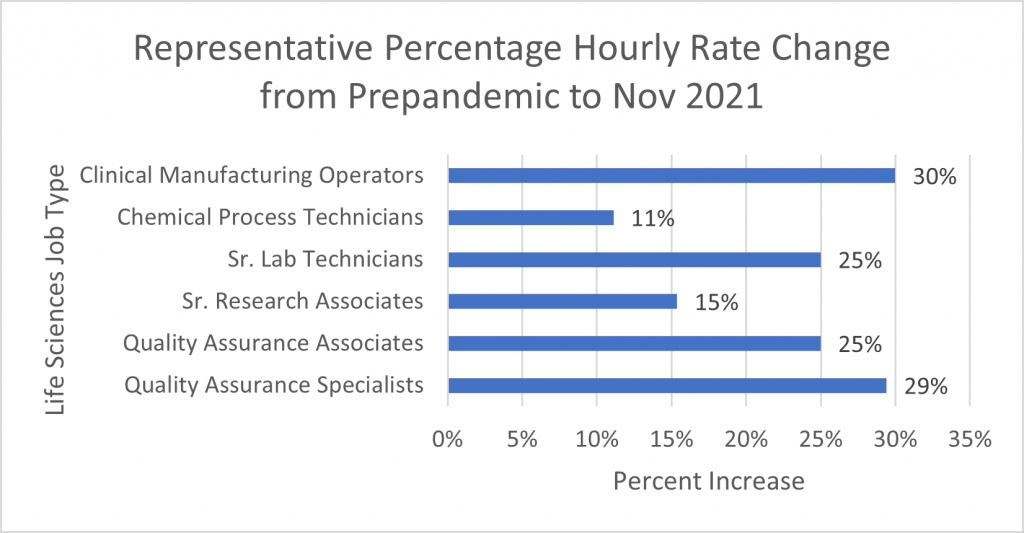
Hire, Retain and Grow Talent Today without Breaking the Bank
How to attract the talent you need to succeed
As anyone who has tried to fill Life Science positions lately can tell you, skilled individuals in a handful of industry sectors have become extremely difficult to find and hire. Growth in the Life Sciences industry is underscored by what’s happening in the real estate market. In just one noted example, MassBio, a Massachusetts-based trade group, found the state had added nearly five million square feet of lab space since the beginning of 2021 and predicts that another 20 million square feet will be built by 2024. According to the trade group, this will generate demand for 40,000 new jobs – or growth of almost 50%! What’s happening in Massachusetts is not an aberration as millions of square feet of what was formerly office space is being converted to lab space. In the six largest U.S. life sciences markets, more than 20% of the new lab spaces are conversions from offices[1]. This growth has not only fueled a vibrant lab real estate market but has also made talent extremely hard to find.
The scarcity of talent is reflected in the costs of hiring Life Sciences workers. The graph below illustrates the magnitude of hourly rate increases for several Life Sciences job titles from before the Covid-19 pandemic until now.

A portion of the growth in Life Sciences is attributable to the race to develop and analyze tests, design and produce personal protective equipment, and create and produce vaccines; however, much of the industry growth predates the pandemic and will continue after the crisis abates. For example, the demand for research associates to work in vaccine production for several types of infectious diseases will continue as will the demand for quality control and quality assurance personnel needed for all types of scientific and medical device-related manufacturing. The bottom line is that the competition for talent in Life Sciences is going to remain intense for the near future.
Non-financial Incentives Help Attract Talent
For mid-size to smaller organizations, competing for talent by offering top dollar salaries or high hourly rates is infeasible. Even larger companies with deeper pockets can find themselves outbid for the skilled talent they need. Organizations need to fashion offers that include competitive salaries, but also need to consider non-financial incentives that might appeal to a segment of the candidate population. A few thoughts to consider include the following:
- Hybrid work with workers spending part of their time working from home and part in the office is probably going to be the most widely embraced work model. A surprising number of job candidates are adamant that they won’t consider offers that don’t include a degree of flexibility regarding working remotely. Of course, this model is not applicable for most lab workers and many other Life Sciences positions, but organizations should look at work processes and allow selected tasks involving data entry, analysis, documentation, etc., to be performed remotely. Inflexibility around this issue could put organizations at a disadvantage when competing for scarce talent.
- Training and upskilling are important in attracting and retaining talent. In a study conducted this year by Gallup and Amazon, 57% of workers were either “very” or “extremely” interested in training to upgrade their skills or to build new ones that would benefit their careers. When the question asked about training being free while workers are paid to attend it, their interest went up to 71%[1]. Hiring firms that offer tuition reimbursement, access to acquiring important certifications, and advanced training opportunities are more attractive to job candidates.
- It might be time to reassess your package of benefits and perks. Even though the quality of life issues have become more important to a segment of job seekers, compensation will still drive many decisions. Organizations are now looking at their 401k matching programs, stock purchase plans, and other financial incentives to make sure that their compensation packages are competitive.
It’s important to stay current on what’s happening in the job market for the types of candidates the organization is trying to attract. The environment is dynamic and recruiting tactics that might have been effective in the past might now be outdated.
Waiting for the “right” candidate might not be the right approach
Frequently, hiring organizations will reject job candidates who don’t have the relevant industry experience – even when they have strong scientific backgrounds. At one time, this approach might have worked but in today’s job market where the demand for scientific workers is overwhelming supply, it’s a recipe for frustration. A growing number of hiring organizations have realized that waiting for the “perfect” candidate is unrealistic – and to a large degree, unnecessary. Organizations that at one time might have insisted that a candidate have sufficient industry experience are hiring from different industries and upskilling the new hires. Whereas not too long ago when a staffing firm would propose a candidate from another industry to a client the client would balk that the recruiter was trying to foist them with something they didn’t ask for – we’re frequently finding that organizations are much more flexible in trading direct industry experience for a candidate’s potential or scientific knowledge.
Recently a mid-sized product company was attempting to hire an engineer with extremely specific industry experience in materials science. Finding the “right” candidate wasn’t working. Astrix recruiters submitted a recent grad from a solid engineering school who also had served in an unrelated industry co-op work program. The hiring organization took a chance on this candidate and with additional training, he is now a department manager.
In another instance, a global biotech company was looking for a Chemical Process Engineer with the appropriate industry experience. Again, Astrix recruiters submitted a candidate who although was working in the chemical industry, was looking to transition into life sciences. He was enthusiastic about his desire to move into biotech and the hiring firm took a chance on him. Three months into his 18-month contract the client converted him to a full-time employee with a large merit increase based on the contributions he had made to the business. People are adaptable and embracing a candidate who is committed to learning new skills and new markets is becoming more widely accepted.
Don’t let your hiring processes slow you down
Organizations with flexible work options, competitive compensation packages, and a willingness to hire candidates with potential rather than direct industry experience can still undermine their effectiveness if their hiring process is too laborious or lengthy. In this job market, even imperfect candidates don’t last long. A qualified candidate might be available for a window of 10 days. The average time-to-fill, which has been increasing for years, is now around 36 days[2]. If hiring organizations looking to fill scientific positions take anywhere near that length of time, they are going to lose qualified candidates and cause themselves other potential problems including:
- Lost revenue as productivity falls due to vacancies
- Damage to brand as candidates grow frustrated and use social media to spread the word
- Reducing the candidate’s desire and enthusiasm to work for the organization
- Developing a reputation as indecisive or slow to act.
- Negatively affect existing employees’ morale and engagement as they must pick up the workload created by the vacancy.
If you are losing good candidates because they are taking offers before you have made one, it’s time to assess your entire hiring process to see how it can be compressed. If reviewing and revamping the interview/hiring process is not an internal strength, we can share our insights and suggestions to shorten your time-to-fill time.
Why this matters to you
Given the intensity of the competition for Life Sciences talent, insights into changes in the job market, hiring processes, candidate attitudes, etc. can give you an advantage when it comes to acquiring the talent you need to prosper. Here are a few takeaways you should take into account:
- The Covid-19 pandemic superheated what was already a hot job market for Life Sciences talent. For many job titles, this has pushed their percentage hourly rate increases into the double digits. If you’re looking to hire, stay current on the rates in your region so your offers are competitive.
- Offering competitive compensation is a start but job candidates are also focused on quality of life issues. When paying high market rates becomes infeasible, consider emphasizing non-financial benefits such as:
- Hybrid work – when feasible, allowing workers to work at least part of the week remotely can give you an advantage.
- Training and upskilling – candidates are more attracted to working for organizations that offer them the opportunity to grow professionally by acquiring new skills.
- Update your benefits package – especially if you haven’t revised it in a while. Salaries and bonuses aren’t the whole story – you might be able to distinguish your organization through a more extensive benefits package.
- Waiting for the “perfect” candidate might have you waiting for a bus that never arrives. Organizations that insist on only assessing candidates who have matching industry experience should be prepared for a lengthy recruitment process. The Life Sciences job market is too competitive for that now. Our advice is to look for candidates who have the appropriate science or discipline background – then assess their ability to adapt and learn.
- Speed up your hiring process – one thing you don’t want to do is to lose a qualified candidate because during the time it took for you to make an offer they accepted another job. There are too many downsides to slow hiring that will only make your recruiting efforts more difficult.
Want to learn more about any of the issues addressed here – or get insights into Life Sciences staffing issues in your location?
[1] https://www.aboutamazon.com/news/workplace/the-american-upskilling-study-shows-workers-want-skills-training
[2] https://www.macslist.org/for-employers/10-ways-a-lose-a-candidate-in-a-tight-job-market
[1] https://www.nytimes.com/2021/07/27/business/office-space-conversion-labs.html
Case Study: LabWare Centralized Data Review for a Global Biopharmaceutical Company
Overview A global biopharmaceutical company specializing in discovery, development,... LEARN MOREWhite Paper: Managing Data Integrity in FDA-Regulated labs.
New White Paper LEARN MORELET´S GET STARTED
Contact us today and let’s begin working on a solution for your most complex strategy, technology and strategic talent services.
CONTACT US



